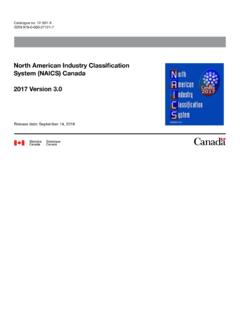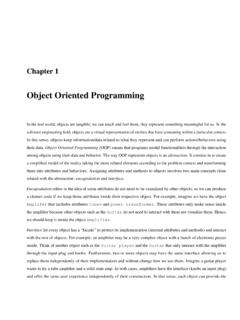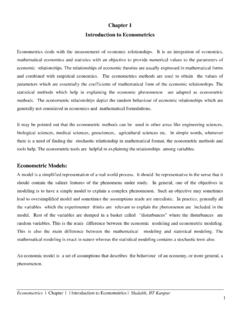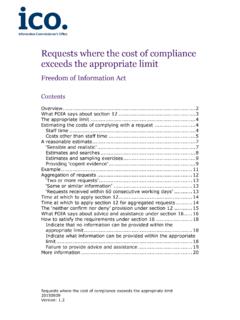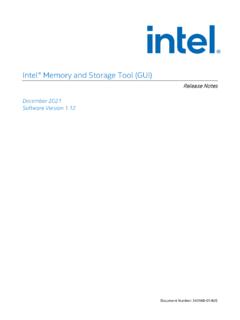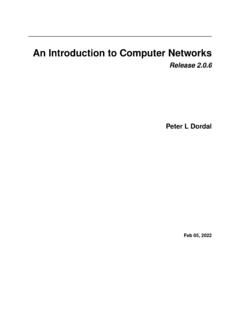Transcription of Government Security Classifications
1 Government Security Classifications May 2018. version May 2018. Page 1 of 37. version May 2018. version History SPF Document Date Summary Of Changes version version Published Oct 13 N/A This document will replace the current Government Protective Marking Scheme' document on 2 April 2014. SPF Document Date Summary Of Changes version version Published May 18 This document will replace Document version for the purpose of making reference to Data Protection legislation as outlined as follows: Overview of Key Principles, paragraph 1, page 4. Official - Definition, page 7. Disclosure, page 27. Including referencing the exemptions to some or all of the data protection principles as outlined as follows: Legal Framework, paragraph b, page 15.
2 The EU-US Privacy Shield replaces the Safe Harbor Agreement, which was held to be invalid in October 2015 by the Court of Justice of the European Union. These changes have been reflected at the Annex, under Part Three, Technical Controls Summary, paragraph 53. Page 2 of 37. version May 2018. Government Security Classifications Executive Summary This policy describes how HM Government classifies information assets to: ensure they are appropriately protected; support Public Sector business and the effective exploitation of information; and meet the requirements of relevant legislation and international / bilateral agreements and obligations.
3 It applies to all information that Government collects, stores, processes, generates or shares to deliver services and conduct business, including information received from or exchanged with external partners. Everyone who works with Government has a duty to respect the confidentiality and integrity of any HMG information and data that they access, and is personally accountable for safeguarding assets in line with this policy. HMG information assets may be classified into three types: OFFICIAL, SECRET and TOP SECRET. Each attracts a baseline set of Security controls providing appropriate protection against typical threats. Additionally, ICT systems and services may require enhanced controls to manage the associated risks to aggregated data or to manage integrity and availability concerns.
4 Government Departments and Agencies should apply this policy and ensure that consistent controls are implemented throughout their public sector delivery partners ( NDPBs and Arms Length Bodies) and wider supply chain. The Government Security Classifications will come into force on 2 April 2014 . until then existing policy remains extant. Cabinet Office December 2012. Page 3 of 37. version May 2018. Government Security Classifications December 2012. Overview of Key Principles 1. This policy describes HM Government 's administrative system for the secure, timely and efficient sharing of information. It is not a statutory scheme but operates within the framework of domestic law, including the requirements of the Official Secrets Acts (1911.)
5 And 1989), the Freedom of Information Act (2000) and Data Protection legislation. Principle One: ALL information that HMG needs to collect, store, process, generate or share to deliver services and conduct Government business has intrinsic value and requires an appropriate degree of protection. 2. Security Classifications indicate the sensitivity of information (in terms of the likely impact resulting from compromise, loss or misuse) and the need to defend against a broad profile of applicable threats. There are three levels of classification : OFFICIAL SECRET TOP SECRET. The majority of information Very sensitive information HMG's most sensitive that is created or processed that justifies heightened information requiring the by the public sector.
6 This protective measures to highest levels of protection includes routine business defend against determined from the most serious operations and services, and highly capable threat threats. For example, where some of which could have actors. For example, where compromise could cause damaging consequences if compromise could seriously widespread loss of life or lost, stolen or published in damage military capabilities, else threaten the Security or the media, but are not international relations or the economic wellbeing of the subject to a heightened investigation of serious country or friendly nations. threat profile. organised crime. 3.
7 Each classification provides for a baseline set of personnel, physical and information Security controls that offer an appropriate level of protection against a typical threat profile. A top level controls framework is provided as an annex to this policy. As a minimum, all HMG information must be handled with care to comply with legal and regulatory obligations and reduce the risk of loss or inappropriate access. There is no requirement to mark routine OFFICIAL information. 4. Organisations may need to apply controls above (or below) the baseline on a risk managed basis appropriate to local circumstances and in line with HMG risk appetite tolerances.
8 The Government SIRO will moderate such instances that entail any pan- Government risk. Page 4 of 37. version May 2018. 5. The classification scheme applies to information (or other specific assets). Major ICT. infrastructure ( large aggregated data sets, payments systems, etc.) may require enhanced controls to effectively manage associated confidentiality, integrity and availability risks determined on a case by case basis following a robust risk assessment. Principle Two: EVERYONE who works with Government (including staff, contractors and service providers). has a duty of confidentiality and a responsibility to safeguard any HMG information or data that they access, irrespective of whether it is marked or not, and must be provided with appropriate training.
9 6. Accidental or deliberate compromise, loss or misuse of HMG information may lead to damage and can constitute a criminal offence. Individuals are personally responsible for protecting any HMG information or other assets in their care, and must be provided with guidance about Security requirements and how legislation relates to their role, including the potential sanctions (criminal or disciplinary) that may result from inappropriate behaviours. A summary of the relevant legal and regulatory context is set out on page 13. 7. Organisations must have a breach management system in place to aid the detection and reporting of inappropriate behaviours, enable disciplinary procedures to be enforced and assist with any criminal proceedings.
10 Principle Three: Access to sensitive information must ONLY be granted on the basis of a genuine need to know' and an appropriate personnel Security control. 8. Information needs to be trusted and available to the right people at the right time. The failure to share and exploit information can impede effective Government business and can have severe consequences ( medical records or case management files). The principles of openness, transparency, Open Data and information reuse require individuals to consider the proactive publishing of public sector information and data sets. However, this must always be a reasoned judgement, taking data protection and confidentiality into account.










